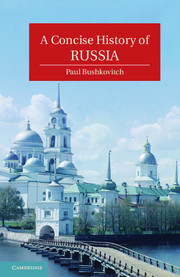Book contents
- Frontmatter
- Contents
- List of Figures
- Abbreviations
- Acknowledgments
- Prologue
- 1 Russia before Russia
- 2 Moscow, Novgorod, Lithuania, and the Mongols
- 3 The Emergence of Russia
- 4 Consolidation and Revolt
- 5 Peter the Great
- 6 Two Empresses
- 7 Catherine the Great
- 8 Russia in the Age of Revolution
- 9 The Pinnacle of Autocracy
- 10 Culture and Autocracy
- 11 The Era of the Great Reforms
- 12 From Serfdom to Nascent Capitalism
- 13 The Golden Age of Russian Culture
- 14 Russia as an Empire
- 15 Autocracy in Decline
- 16 War and Revolution
- 17 Compromise and Preparation
- 18 Revolutions in Russian Culture
- 19 Building Utopia
- 20 War
- 21 Growth, Consolidation, and Stagnation
- 22 Soviet Culture
- 23 The Cold War
- Epilogue
- Further Reading
- Index
19 - Building Utopia
Published online by Cambridge University Press: 05 June 2012
- Frontmatter
- Contents
- List of Figures
- Abbreviations
- Acknowledgments
- Prologue
- 1 Russia before Russia
- 2 Moscow, Novgorod, Lithuania, and the Mongols
- 3 The Emergence of Russia
- 4 Consolidation and Revolt
- 5 Peter the Great
- 6 Two Empresses
- 7 Catherine the Great
- 8 Russia in the Age of Revolution
- 9 The Pinnacle of Autocracy
- 10 Culture and Autocracy
- 11 The Era of the Great Reforms
- 12 From Serfdom to Nascent Capitalism
- 13 The Golden Age of Russian Culture
- 14 Russia as an Empire
- 15 Autocracy in Decline
- 16 War and Revolution
- 17 Compromise and Preparation
- 18 Revolutions in Russian Culture
- 19 Building Utopia
- 20 War
- 21 Growth, Consolidation, and Stagnation
- 22 Soviet Culture
- 23 The Cold War
- Epilogue
- Further Reading
- Index
Summary
Starting in 1929, the Soviet leadership began to transform the society of the USSR, to build an industrialized modern state, but not a capitalist state. The new society was to realize the old dream of socialism, a place without private property where the state ran and managed production of goods and services for the benefit of everyone. This was the idea. The reality that emerged after more than a decade of upheaval served as the framework of the Soviet Union until its demise two generations later.
The basic outlines were in place at the end of 1927 with the first five-year plan and the course toward collectivization of agriculture. The plan was to last from the beginning of 1928 to the end of 1932, and called for a twenty percent annual increase in industrial production, a rate of growth that was unheard of at the time. Such a growth rate implied a huge increase in urban population, and that required much more food than the country produced with its backward peasant agriculture. To complicate matters, grain exports were the Soviet Union's main source of hard currency to buy the new industrial equipment abroad that was essential for rapid industrialization. The solution was to be the collectivization of agriculture, which would increase per acre yield and free millions of hands to work in the new industry. The original plan for the pace of collectivization was moderate, with about a fifth of peasant households to be collectivized by the end of 1932.
- Type
- Chapter
- Information
- A Concise History of Russia , pp. 351 - 370Publisher: Cambridge University PressPrint publication year: 2011

